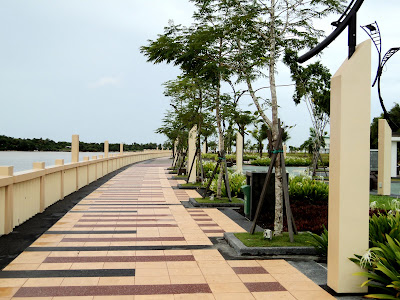
Daisy joy riding around Saratok town.

On Monday ( 25th Oct), we were back on the road again.
Daisy and Inul joined us for the 11 hours-long journey. As usual Daisy made the trip into a sleeping marathon. Inul was a bit panicky for the first hour of the journey but soon got calmed down by Daisy's continual grooming and assurance. At one point when Daisy could't stand Inul's cries she screamed at her and when Inul knew of her Mama's anger, she remained quiet for the rest of the journey. On this journey Inul preferred to stay at the back seat (
see inset). We left Kuching at 8.30 am and arrived Bintulu
at 7.00 pm. Throughout the journey the skies were cloudy and not a single drop of rain fell on us. Towards the middle of the journey we decided to check out the small town of Saratok, a seven kilometer diversion from the main Pan Borneo Highway. Daisy had lots of photo taking sessions while driving around town albeit sitting on the dashboard (
see top picture)

Sitting on the dashboard and having a clear view of the road, Daisy was perplexed to see the line drawings on the road surface as we came nearer to Sibu. "Fospa, which way shall we go? " she asked. With a right turn to Sibu or left to Bintangor? Bintangor is the new name for a town of little prospects. It is for this reason that many enterprising men from Bintangor made it big in Bintulu. " Who would like to work in a town of animals?" asked Daisy. The Sarawak state administration changed the name 'Binatang' town to " Bintangor" a couple of years ago for a good reason. In the local Malay dialect 'Binatang' means animal while " Bintangor" refers to a local tree which people claim to have properties for the cure of aids. Now imagine if you are to tell the next soul that you are a ' Binatang' man or woman originally. "Ok, you don't have to tell me you're wild lady! I'm as wild as can be', meowed Daisy.

A typical street scene in Sibu.
Recently the Foochow Chinese in this town had an emotional debate on the need to change the name of Sibu town to another name yet to be decided. The main reason was that the word " Sibu " when pronounced in Chinese means 'the witch', thus bearing ill luck. Why now? Long before the Chinese migrated to Sibu from China in the early 1900's, the Ibans and other natives have always called the place as 'Sibau' after a local fruit prevalent in the locality. When the British colonized Malaya and Sarawak, they prefered to pronounce and write local names to accomodate their linguistic idosyncracies. Recall 'Pulau Pinang' was pronounced 'Penang' due to the clumsy British tongue. Closer at home, there's a place in Bintulu called 'Sebezau' prounced beautifully in the local Bintulu Melanau dialect but got written on the maps and official letters as " Sebiew" or " Sibiyu" following the English pronounciation and have remained ever since . I think you can cook more examples of other place names, just add on the list. So how should Daisy be called? DAZY? DIZZY? "Can't even try, I'm no Britsh" meowed Daisy.
 I attended a Malay wedding function today held at my close relative's place. The bride is my cousin's daughter. In the picture above her uncle Haji Alwi is seen performing the " Tepung Tawar" ceremony as a way of blessing the newly-wed couple.
I attended a Malay wedding function today held at my close relative's place. The bride is my cousin's daughter. In the picture above her uncle Haji Alwi is seen performing the " Tepung Tawar" ceremony as a way of blessing the newly-wed couple. This signboard has been erected quite recently and the name speaks it all. "Pantai" is beach in Malay. "Temasya" connotes fun-time, recreational activity and a gathering of happy people. And all this happens at Bintulu's closest public beach from the town center which is near Tanjung Batu area.
This signboard has been erected quite recently and the name speaks it all. "Pantai" is beach in Malay. "Temasya" connotes fun-time, recreational activity and a gathering of happy people. And all this happens at Bintulu's closest public beach from the town center which is near Tanjung Batu area.














































